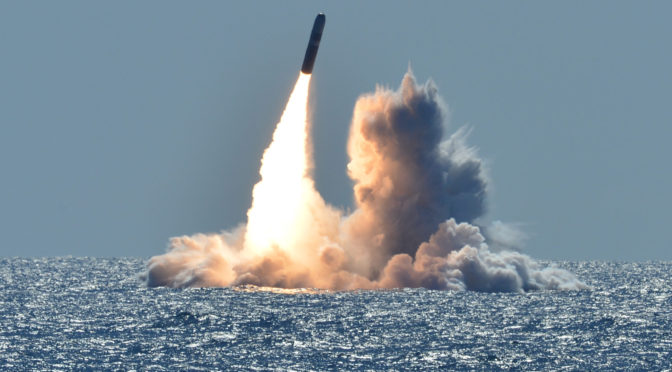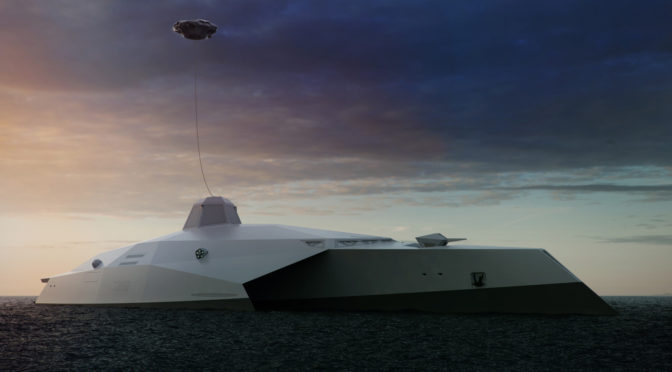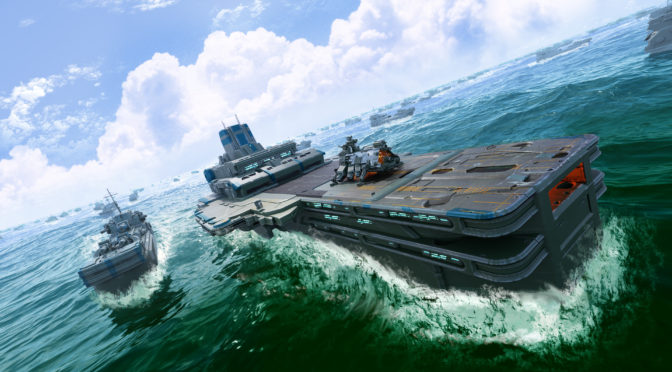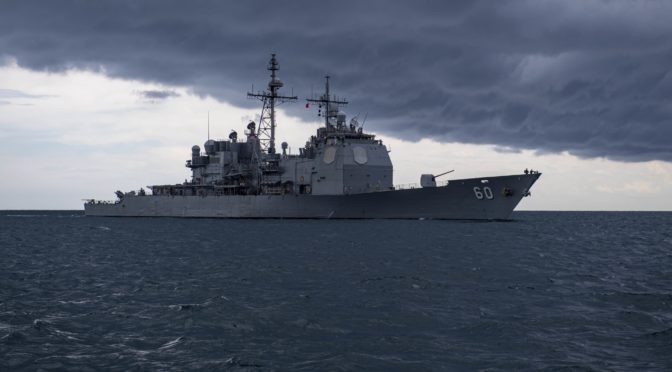The following excerpt is from David Poyer’s latest novel, Violent Peace: The War with China: Aftermath of Armageddon, and is republished with permission.
By David Poyer
In the event, he had to get another dose of vaccine, a shot this time, since the version Homeland had given him hadn’t been approved by DoD. Then he had to cool his heels for two hours before he got to see the CNO’s flag secretary.
She was new, and didn’t seem to have any idea who he was. And of course since he was in a rumpled, oil-stained uniform, and probably stank of exhaust and sweat and too many days sleeping rough, he had to explain. Looking skeptical, she’d gone in to notify her boss.
And come out smiling. “He’ll be with you shortly, Admiral. I’m so sorry. I should have recognized your name. Task Force 91, right? Operation Rupture Plus?”
“That’s me.”
“I wish I could have been there. But some of us had to hold the fort here in DC.”
“I understand completely.” Dan forced a smile and got up, but staggered as a wave of dizziness rushed over him. From the dual vaccinations, probably.
“Are you all right, sir? Should I call—”
“Yeah. I’m fine. Just been . . . I’m fine.” He braced a finger against the bulkhead until the vertigo passed, then followed her into Niles’s office.
His old mentor, then enemy, then reluctant rabbi again, had lost a shocking amount of weight. Barry “Nick” Niles’s service dress blouse sagged loosely on a once-massive frame. His shirt collar gaped around his neck. His color seemed less that of a healthy African American than the hue and texture of gray wax. And he’d apparently gone to the shaved-head look. But his first words, from behind his desk, were robust. “Where the hell have you been, Lenson?” he boomed, just like the old Niles.
Dan came to an awkward attention. “I had leave, Admiral.”
“That doesn’t mean you drop off the face of the planet. Where were you?” Niles squinted. Sniffed the air. “Do you smell gasoline?”
“I bought a motorcycle. My daughter was kidnapped. So I . . . I was trying to pick up her trail across country.” The CNO nodded. “And did you?”
Dan swallowed, fighting a tickle in his throat and a sudden desire to weep. The dizziness peaked, then receded again, like a tide. He blinked rapidly, looking toward the shatterproof windows. “No. No, sir. I lost track of her in Wyoming. No telling where they went after that, or . . . what they did with her. There’s a body in Nebraska that . . . is . . . that may be her. I couldn’t make a positive identification.”
The CNO nodded heavily. Grunted. Muttered, after a moment, “Sorry to hear. I know it doesn’t help to hear it, but a lot of other people are missing relatives, friends, kids . . . two of my nephews, working oil out west, not a word since the laydown.”
“Things are confused out there, sir. They could just be in one of the camps.”
Niles waved his hope away and picked up a piece of paper. Seemed to remember Dan was standing, and pointed to a chair. No offer of an Atomic Fireball, as in the old days. The bowl was empty. Maybe they’d stopped making them during the war.
He sagged gratefully into the armchair. Cleared his throat, and tried to focus as Niles set the paper aside.
“You been home? Seen Blair yet?”
“No sir. Came straight here.”
“Uh-huh . . . uh-huh. Well, good work out there with Rupture, Dan. If I haven’t made that clear. If you hadn’t stopped the clock to build up your ammo and fuel reserves, then kept shoving when the going got rough, we’d have gotten kicked back into the China Sea.”
“Yes sir. Resistance was a lot heavier than I expected.”
“Than anyone expected. Including our intel and our AI. That took a lot of moxie, to keep driving ahead when you were looking at casualty reports of twenty, thirty percent.” Niles tented his fingers. “Of course, if that’d been the wrong decision, we would have hung you by the balls.”
Dan figured that for a rhetorical statement, so simply nodded. And waited for the other boot to drop.
Niles searched through what was apparently Dan’s personnel file, though it seemed odd that it was printed out. He rumbled to himself, as if musing, then said a bit louder, “Your stars may be permanent.”
“Oh. Is that right, sir?” It didn’t seem that important, but he tried to look gratified.
“At least you’re on the postwar list for Senate confirmation. Nothing’s guaranteed these days.” He sighed, sat back, glanced out the window. “We’re having to fight for every flag billet. There’s a lot of pushback about anything to do with the Pacific. We need to pull two carriers back for core replacement and overhaul. That’s going to be a major fight in the next budget. There are already calls to scrap them, rather than refuel.”
“Then, thank you, sir. For the nomination, at least.”
Niles shrugged and rolled his eyes, and Dan added, “I saw something new on the way in here. Something called a Homeland Battalion.”
“Uh-huh. In black uniforms?”
“Yes sir.”
“Uh-huh.” Niles tilted a massive head. “Homeland Security’s amalgamating loyal Guard units and militias into Blackies. Also known as Special Action Forces. And they want new general billets for them. They’re not DoD formations, they’re DHS, but they count against our general and flag authorized strengths.”
“That doesn’t sound exactly . . . fair, Admiral.”
Niles’s eyelids flickered. “There’s worse coming over the horizon. Posse Comitatus may be suspended. To fight the unrest in the cities, and out west. And the closer we get to the elections . . . the slogan’s ‘Forward as one,’ but the reality may be that we’re headed for one-party rule.”
Niles looked away. “Some of us are determined not to let that happen. At least, not if we can prevent it.”
Dan weighed that last sentence. Then, despite himself, glanced around the office.
The admiral caught his reaction, and waved a large hand. “You can speak freely. This room’s a SCIF. Noise suppressors on the walls, and we sweep it every morning. One island we keep as sane as we can. The Joint Chiefs, I mean. Just don’t face the windows if you’re discussing anything you don’t want overheard.”
“Yes sir.” He wanted to know more, but decided he’d better digest what had just been intimated first. Because Niles’s words could be construed, in the wrong hands, into something close to treason.
Niles reached for the empty candy container, but halted his hand halfway. He rumbled, “I’m going to be stepping down pretty soon, Dan. We won, if you can call losing ten million lives a win. And I’m tired.”
“Ten million,” Dan repeated blankly, horrified. This was the first he’d heard of any round figure. Most of the deaths must have taken place within the areas he’d routed around in his trek east. Plus fallout effects, carried by the wind. Radiation, looting, revolt, disease . . . so the dying wasn’t over yet. He straightened his shoulders. “You’re punching out, sir? Retiring?”
Niles rubbed a palm over his bare scalp. His smile resembled a sardonic jack’o lantern’s. “I have pancreatic cancer, Dan. They’re treating it, but as you can see, it’s a losing battle. I’d rather not die walled up in this fucking office. Scenic as the view is.”
“No sir. Of course not. I don’t—I’m very sorry to hear that.”
A tap at the door, and the aide stuck her head in. “Five minutes, Admiral.”
Niles sighed. He stood from behind the desk. Dan, rising too, saw anew how shrunken his old senior’s body was beneath the now nearly tent-like blues. Niles shrugged again. “That’s the cookie . . . Anyway, you’ll want to know what’s next for you. It’s still up in the air. Jung Min Jun called. He wants you as ambassador to reunited Korea. I told him that was a nonstarter. No way the administration would go for it, and you weren’t a fucking diplomat anyway.”
Dan nodded, not chagrined. Dealing with Jung could be stressful, and he wasn’t eager to leave home again. “Yes sir. So what were you thinking?”
The CNO waved the question away. “Let’s talk about that next time you come in. For now, go home. Take a shower. See Blair. Get some sleep. We all need a rest. Still got that boat of yours? Go sail it. Come back in when you feel up to it. Three, four days or so. Tell Marla to give you a District pass and a ration card.”
Niles looked at the papers again, a contemplative, lingering glance. Then shoved the chair back and came around the desk. He didn’t move like a lumbering bear anymore. His steps seemed tentative, cautious. His grip, though, was still strong as he pincered Dan’s shoulder. “We go back a long ways, Lenson. All the way to Crystal City and the JCMPO. I’ve been hard on you at times, I guess.”
Dan forced a smile. “No more than I deserved, sir.”
“But I fought for you too, when you needed it. The way I hear you do for your own people.”
“Your example, Admiral.”
“An officer who knows when to take a risk, even dares to disobey, for the good of the service—that’s a rare thing. We were headed for a zero-risk Navy for a long time, before this war. I tried to fight that, whenever I could.” Niles held out his hand. “I guess after all these years you’d better make it Nick. In private, at least.”
Dan’s eyes stung. At the Academy, spooning—a senior’s giving a junior permission to use a first name—was a time-honored tradition. One never given lightly. He cleared his throat and took the proffered hand. “Yes sir. I mean, Nick.”
“Sir?” said the aide, from the door. “Before you leave. Legal wants a word.”
“Legal? Hell. Well, make it short,” Niles said, turning away, letting go Dan’s hand, clearly annoyed.
A tall woman in blues introduced herself. She carried a red striped folder. “I heard Admiral Lenson was in the building.”
“Get to it,” Niles growled.
She turned to Dan. “The notification by the ICJ. Admiral, has anyone discussed this with you?”
The International Court of Justice. “Uh, my wife mentioned it.”
“Blair Titus,” Niles clarified. “Undersecretary of defense.”
The legal officer nodded. “Yes sir. I thought as long as he was here, we could go over the administration’s stand. That no US citizen will be judged.”
Dan said, “But doesn’t that mean the Chinese won’t attend either?”
Niles shook his head. “They’re trying to take that position. But they signed the treaty. Giving up war criminals was one of the stipulations.”
“That’s actually a political question, Admiral.” The attorney clasped her hands primly in front of her, elbows out. “It goes to war guilt, if we still want to align ourselves with that concept. But if we do, the ICJ may indict Americans as well. As they may with Mr. Lenson, here.”
Niles said irritably, “Forget it. He’s not responding.”
“What happens if I don’t?” Dan said, accepting that he probably wasn’t going to, but also curious as to what would happen if he didn’t.
“You wouldn’t be able to travel to Europe, probably,” the advisor said. “At least to Europe, the UK, the other standing members of the court. If you did, you’d be subject to arrest, extradition, and trial.”
Niles patted his arm. “Don’t lose any sleep over this, Dan. This’ll all get settled way above our pay grades.”
He nodded to the aide, who stepped aside to let them both pass.
_______________________________________
DAN stopped by Blair’s office, but her people said she was overseas, in Singapore. “Oh, yeah,” he muttered. “The peace conference.” He stopped in at the cafeteria and put a lunch on his new ration card.
Next stop: home, in Arlington. And just about time; the bike was down to a top speed of forty, and its smoke trail was like a burning bomber’s.
He shut the engine down and rolled the last few feet down the driveway.
The house looked . . . deserted. Desiccated pine needles carpeted the roof, with patches of green moss. One of the gutters had come loose and hung down like a torn hem. The shingles needed attention. The lawn had grown two feet high, and Virginia creeper and the red hairy cables of poison ivy twisted through the undergrowth and up the trunks of the pines, clinging and strangling. He’d have to take a machete to them.
Around back, he found the spare key under a brick in the patio. Let himself in to first quiet, then alarmed mewing. He scooped Blair’s cat up and cradled it, ruffling its fur. “Hey, Jimbo.” Remembering suddenly how he’d cradled his daughter the same way, so many years ago.
The house smelled musty. No wonder; the windows were taped over, as if for a hurricane, and duct-taped shut, no doubt as a preparation against fallout, though it hadn’t reached this far east. He fed the cat, then let himself down the narrow steps to the basement. Here, in his study, it smelled even worse, as if the books were moldering. He went back up and checked the air-conditioning. But a crimson sticker sealed the breaker in the off position: Save Energy for Victory.
So he went around untaping and opening the windows and sliding down the screens. Not much of a breeze, but it might cool the house a bit. He checked the refrigerator: empty. The panty was bare too, except for a few staples: olive oil, beans, rice, canned stuff, bottles of wine. Blair must have been getting her meals at work.
He stood at the window, watching squirrels squabble and play in the pines. Feeling suddenly . . . aimless. Apprehensive.
Fuck that! He should feel relieved, right? The war was over.
And the US had “won.”
Yet he’d lost too much to feel relieved, or happy, or even curious about what came next. An indictment? He couldn’t muster concern for that, either. Like the legal beagle had suggested, maybe the whole concept of “war guilt” was a thing of the past. Quaint, like honor, or virtue, or truth, or the idea noncombatants weren’t legitimate targets.
He just felt . . . empty. Peculiar, out of place, as if this were some uncanny, alternate world he’d never expected to inhabit. And guilty, too, as if by surviving he’d betrayed those who had not.
The wine, in the pantry. He could uncork it. Forget all this. Blot it out, if only for a few hours.
No. He’d been sober for too many years. The craving faded. It wouldn’t help. When he woke up tomorrow, his daughter would still be dead.
He’d have to learn to live with that. Somehow. Like millions of others, all across the US. Across China. Pakistan. India. Indonesia. Iran. Vietnam. In all the countries this war had wrecked, trampled, and poisoned. Remember that, he told himself. You’re not the only one. He looked at the coffeemaker, but decided Niles was right. He needed a shower, a good long sleep more.
Upstairs, to a rumpled bed. The comforter was pulled up haphazardly, as if his wife had left in a hurry. Stooping to the pillow, he could smell her. Her lotions and emollients stood lined up in the bathroom. He peed, got a quick shower, then lay down. Blinked at the ceiling.
He didn’t bother to set the alarm.
David Poyer’s sea career included service in the Atlantic, Mediterranean, Arctic, Caribbean, and Pacific. He’s the author of nearly fifty novels and works of nonfiction, including the Dan Lenson War with China series: Tipping Point, Onslaught, Hunter Killer, Deep War, and Overthrow. His next book, Violent Peace, will be published this December. Poyer’s work has been required reading in the Literature of the Sea course at the U.S. Naval Academy, along with that of Joseph Conrad and Herman Melville. He lives on the Eastern Shore of Virginia.
Featured Image: PACIFIC OCEAN (March 26, 2008) An unarmed Trident II D5 missile launches from the Ohio-class ballistic missile submarine USS Nebraska (SSBN 739) off the coast of California. (U.S. Navy photo by Mass Communication Specialist 1st Class Ronald Gutridge/Released)




